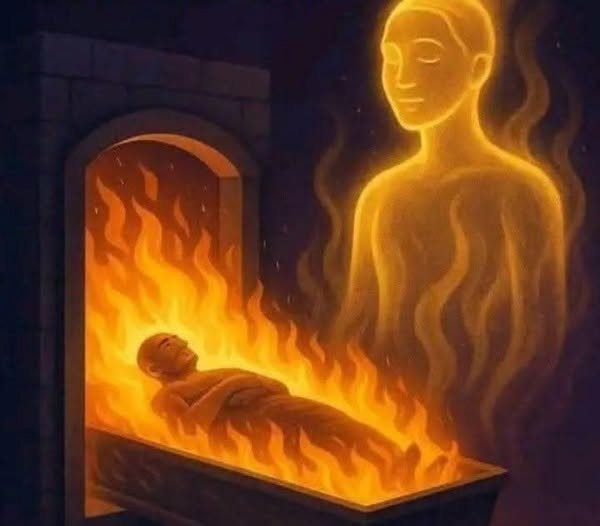The passing of a loved one is one of life’s most profound experiences. In these moments of grief and reflection, many people naturally begin asking spiritual questions that transcend the boundaries of daily life. Among these questions, one of the most common and deeply felt is: What happens to the soul when the body is cremated?
While science can clearly describe the physical process of cremation, the mystery of the soul and its journey after death has been a subject of contemplation for thousands of years. Across different religions, cultures, and philosophies, answers vary widely. Some traditions view cremation as a sacred act of purification that allows the soul to move forward, while others prefer burial, believing it better honors the body as a vessel of divine creation. Still others interpret the soul symbolically, seeing it as a way to describe the human legacy and memory that continues after death.
This article explores these diverse perspectives—spiritual, cultural, philosophical, and modern—while maintaining respect for all beliefs. By examining the different ways people interpret the connection between cremation and the soul, we can find both understanding and comfort in the universal search for meaning.
Cremation in a Global Context
A Historical Overview
Cremation is not a new practice; it has existed for thousands of years. Archaeological evidence shows that cremation was practiced in parts of Europe and Asia as far back as the Stone Age. Ancient Greeks and Romans often cremated their dead, believing fire was a purifying force that could separate the soul from the body. In contrast, early Christians and Jews emphasized burial, viewing it as an act of respect for the body created by God.
Over time, the practice of cremation has shifted in meaning depending on cultural and religious contexts. In some places, it was seen as a noble act of purification; in others, it was viewed with suspicion or disapproval.
Cremation in Modern Times
Today, cremation has become increasingly common worldwide. In many countries, such as Japan and India, it is the primary method of handling remains. In Western societies, cremation rates have risen significantly in recent decades, partly due to practical reasons such as cost and availability of burial space, but also because families are becoming more open to diverse spiritual interpretations.
Even though cremation is now widely understood as a physical process—intense heat reducing the body to ashes—the spiritual implications remain an area of mystery and personal interpretation.
The Spiritual Dimension of Cremation
At the heart of the question lies a distinction: cremation is physical, but the soul is spiritual. Many traditions hold that the soul does not remain bound to the physical body after death. Instead, cremation is seen as a symbolic or literal release, helping the soul continue its journey.
Fire has long been regarded as a purifying force in human history. In both religious and philosophical traditions, fire represents transformation, renewal, and passage from one state of existence to another. Cremation, therefore, is not merely a practical choice but often carries deep symbolic weight.
Still, interpretations vary widely, and each belief system provides its own answers.
Religious Perspectives on Cremation and the Soul
Hinduism
In Hinduism, cremation is not only accepted but strongly encouraged. The religion teaches that the soul, or atman, is eternal and continues beyond the death of the body. Death is viewed as a transition, not an end.
The act of cremation serves an important role in helping the soul separate from the body. Hindus believe in samsara, the cycle of birth, death, and rebirth. Cremation, through the purifying element of fire, allows the soul to detach from the physical form and move on to its next existence.
Ceremonies surrounding cremation are also significant. Rituals such as the chanting of mantras, the offering of ghee to the sacred fire, and the scattering of ashes in holy rivers are performed to support the soul’s peaceful transition.
Ultimately, cremation in Hinduism symbolizes liberation and renewal.
Buddhism
In Buddhism, cremation is also widely practiced. The Buddha himself was cremated, setting a precedent for many followers. Buddhism teaches impermanence—the understanding that everything is temporary, including the body.
The soul, or consciousness, is believed to continue through cycles of rebirth until enlightenment is reached. Cremation is viewed as a natural way to honor impermanence and support the journey of consciousness.
Rituals often emphasize compassion, mindfulness, and prayers for the deceased’s peaceful rebirth. For Buddhists, cremation reflects both the practical and symbolic aspects of the path toward liberation.
Christianity
Christianity has a more complex relationship with cremation. Traditionally, the Church emphasized burial, reflecting the belief in bodily resurrection at the end of time. For centuries, cremation was discouraged or even prohibited, as it was thought to conflict with faith in resurrection.
In modern times, however, attitudes have shifted. Many Christian denominations now accept cremation, provided it is not chosen as a rejection of resurrection beliefs. The Catholic Church, for instance, allows cremation but prefers that ashes be kept in sacred places such as cemeteries or columbaria, rather than scattered.
For Christians, the focus remains on the soul’s eternal life with God, while cremation is understood as a respectful option for the body.
Islam
In Islam, cremation is generally prohibited. The body is viewed as a trust from God, and burial is required to honor that trust. Islamic teachings emphasize that the body and soul are closely connected, even after death, and the body should be treated with dignity.
Muslims believe that after death, the soul enters a stage known as Barzakh, an intermediate state before the Day of Judgment. Because of these beliefs, cremation is not practiced within Islamic tradition.
Judaism
Judaism traditionally favors burial over cremation. The body is seen as sacred, created in the image of God, and deserving of respectful treatment. Burial is also connected to the belief in resurrection.
However, within modern Jewish communities, perspectives vary. While Orthodox Judaism strongly maintains the burial tradition, more liberal branches may permit cremation under certain circumstances.
Other Faiths and Spiritual Traditions
Beyond the major religions, there are countless interpretations of cremation and the soul:
- Indigenous traditions may view cremation as a way to return the body to natural elements while honoring ancestral spirits.
- New Age philosophies often see cremation as a symbolic act of transformation, with the soul moving into higher realms of consciousness.
- Secular or humanist perspectives may focus less on the soul and more on memory, legacy, and the way loved ones are remembered.
Cultural Traditions Beyond Religion
Even in secular societies, cremation carries cultural significance. Families often create personalized rituals to honor loved ones, such as scattering ashes in meaningful locations, placing them in urns, or creating memorial jewelry.
These practices show that even without explicit religious belief, cremation remains deeply symbolic. It provides families with a sense of closure and a way to continue honoring the memory of the deceased.
Philosophical and Psychological Views
Philosophical Perspectives
Philosophers across history have debated the nature of the soul. Plato viewed the soul as immortal, temporarily housed in the body. Modern philosophy often interprets the soul symbolically, as a way of describing consciousness, personality, or essence.
From this perspective, cremation does not affect the soul itself, but instead becomes a ritual through which the living express their understanding of mortality and transformation.
Psychological Perspectives
Psychologically, cremation can serve an important role in the grieving process. The ritual provides a sense of closure and allows families to engage in symbolic acts that represent letting go. The scattering of ashes, for example, can be experienced as a physical metaphor for release, helping individuals cope with loss.
Fire, in this context, becomes not only a physical element but also a symbolic one—representing change, continuity, and renewal.
Modern-Day Discussions Around Cremation
As societies become increasingly multicultural and environmentally conscious, new perspectives on cremation are emerging.
- Eco-Friendly Alternatives: Some people explore options such as water cremation (alkaline hydrolysis) or natural burial, which minimize environmental impact.
- Technology in Memorialization: Digital memorials, online remembrance platforms, and even virtual reality memorials allow families to honor loved ones in innovative ways.
- Multicultural Acceptance: In diverse societies, different practices and beliefs about cremation coexist, encouraging greater respect for individual choice.
These developments show that while the mystery of the soul remains timeless, the ways in which we approach death and remembrance continue to evolve.
Conclusion
The question of what happens to the soul after cremation is one without a single answer. Depending on religious belief, cultural tradition, or personal philosophy, interpretations vary widely. For some, cremation is a sacred act of purification that helps the soul move forward. For others, burial is essential to honor the body and soul together. Still others view the soul symbolically, focusing on memory and legacy.
What remains universal is the human desire to honor loved ones with dignity, respect, and meaning. Whether through fire, earth, ritual, or remembrance, the essence of the soul—understood differently by each tradition—continues to inspire reflection and hope.
In the end, cremation reminds us of life’s greatest mystery: that while the body may return to nature, the soul, in its many interpretations, remains a symbol of continuity, love, and the eternal search for truth.



